Comments / Questions (24)
![]() Greverand wrote:
Greverand wrote:
Bonjour, dommage que vous ne m étiez pas le nombre de mailles que l on doit avoir à la fin de chaque rang. A partir du 12 ème rang sur la banane épluchée, je ne comprends plus le tuto. Merci
28.08.2024 - 17:56
![]() Anna wrote:
Anna wrote:
Nie rozumiem 12 okrążenia proszę mi to prosto objaśnić może być jakiś schemat ,zdjęcie,filmik cokolwiek. Dziekuje
07.08.2024 - 13:52DROPS Design answered:
Witaj Aniu, OKR. 12: Dodać 1 oś w każde z 2 pierwszych oś (czyli przerabiać 2 oczka ścisłe w każde z 2 pierwszych oczek ścisłych), przerabiać 1 oś w każde z 4 nast. oś, zamknąć 4 oś ponad 8 nast. oś - PRZECZYTAJ ZAMYKANIE OCZEK (czyli przerabiać 2 oczka ścisłe razem 4 razy), 1 oś w każde z 4 nast. oś, dodać 1 oś w każde z 2 ost. oś (czyli przerabiać 2 oczka ścisłe w każde z 2 ostatnich oczek ścisłych)= 20 oś. Pozdrawiam!
08.08.2024 - 09:27
![]() Aitana wrote:
Aitana wrote:
No entiendo como empiezas a tejer y en lo de "trabajar en redondo, en espiral" tampoco es que diga mucho :( Parece que empieces es el trabajo con una cadeneta en vez de con un anillo mágico (que es como yo lo empezaría)
29.04.2021 - 17:59DROPS Design answered:
Hola Aitana, hay diferentes maneras de comenzar la labor en espiral con el ganchillo. Puedes hacer un anillo mágico o comenzar en la 1ª cadeneta, como hacen en este patrón. Es decir, puedes empezar directamente con 3 p.b en un anillo mágico y seguir con lo demás.
30.04.2021 - 22:40
![]() Micky wrote:
Micky wrote:
Mag dit patroon ook gebruikt worden om het uiteindelijk product (de groenten) te verkopen via een webshop?
19.01.2021 - 06:57
![]() Pookie wrote:
Pookie wrote:
Lovely pattern that I’ve completed but it would have been easier had the stitch count for each round had continued. It ended at row 12. Having the stitch count really helps to know you are doing things right. :)
10.01.2021 - 19:17
![]() Denise wrote:
Denise wrote:
In round 32 of the banana, I don’t understand “work 12 sc with 1 sc in every sc”. Please clarify
27.12.2020 - 23:03DROPS Design answered:
Hi Denise, This means that you end up with the same number of sc's; no increases or decreases, 1 stitch in each stitch. Happy crocheting!
28.12.2020 - 07:36
![]() Camille wrote:
Camille wrote:
Bonjour ! Je n'arrive pas à commencer la peau de banane. C'est bien expliqué mais je n'y arrive pas... Auriez vous une vidéo ?
12.12.2020 - 14:38DROPS Design answered:
Bonjour Camille, crochetez le 1er rang en piquant le crochet dans chacune des mailles du dernier tour en jaune: piquez le crochet entre 2 mailles (vers l'intérieur de la banane) et ressortez-le à gauche, juste après cette maille et faites votre maille serrée, piquez le crochet là où vous l'avez ressorti pour la 1ère maille et ressortez-le après la maille suivante et terminez votre maille serrée, et ainsi de suite jusqu'à ce que vous ayez crocheté 6 mailles serrées pour la 1ère des peaux. Bonne continuation!
14.12.2020 - 08:10
![]() Emily wrote:
Emily wrote:
Hi there. I am having some trouble understanding the last part of the banana with skin. How do I start to crochet the skin part? I've reread it a number of times and I can't seem to get it.
04.04.2020 - 03:17DROPS Design answered:
Dear Emily, you will crochet the skin with yellow inserting crochet hook in the 20th round of the banana, ie the last round in yellow, and crochet over 1/3 of the stitches (= 6 stitches) to get a total of 3 skins. Happy crocheting!
09.04.2020 - 13:01
![]() Anikjl56 wrote:
Anikjl56 wrote:
Oh merciiii bcp Mme drops pr votre reponse passez une bne après-midi 😘!!
07.11.2017 - 13:41
![]() Anikjl56 wrote:
Anikjl56 wrote:
Bonjour je n'ai pas trop compris combien elle mesure une fois fini merci pour votre aide et bon lundi après midi!!😘!
06.11.2017 - 14:46DROPS Design answered:
Bonjour Anikjk56. D'apres une des photos, la banane a des mesures plus ou moins reelles. Bon travail!
07.11.2017 - 10:13
Monkey business#dropsmonkeybusiness |
|
 |
 |
Crochet toy banana in DROPS Paris.
DROPS Children 23-63 |
|
|
BANANA WITHOUT SKIN: WORK IN THE ROUND IN A CIRCLE: After last sc on the round, continue to next round with 1 sc in next sc (= first sc from previous round). NOTE: Insert a marker at the beg of round between last sc and first sc on the round, move the marker upwards when working. INCREASE TIP: Inc 1 sc by working 2 sc in next sc. DECREASE TIP: Dec 1 sc by working 2 sc tog as follows: * Insert hook in next sc, get thread *, repeat from *-* one more time, make a YO and pull thread through all 3 sts on hook. -------------------------------------------------------- BANANA WITHOUT SKIN: Worked in the round in a circle. Ch 2 with strong yellow on hook size 4.5 mm/ US 7. ROUND 1: Work 3 sc in 1st ch - READ WORK IN THE ROUND IN A CIRCLE. ROUND 2: Inc 1 sc in every sc = 6 sc. ROUND 3: Inc 1 sc in every sc = 12 sc. ROUND 4: Work 1 sc in every sc. ROUND 5: Work 1 sc in every sc but inc 1 sc in 1st and last sc on round = 14 sc. Repeat 4th and 5th round (i.e. inc 1 sc in 1st and last sc on every other round) so that there are 20 sc on round. ROUND 12: Inc 1 sc in each of the first 2 sc, 1 sc in each of the next 4 sc, dec 4 sc over the next 8 sc - READ DECREASE TIP, 1 sc in each of the next 4 sc, inc 1 sc in each of the last 2 sc = 20 sc. ROUND 13 and 14: Work 1 sc in every sc. ROUND 15: Inc 1 sc in each of the first 3 sc, 1 sc in each of the next 4 sc, dec 4 sc over the next 8 sc, 1 sc in each of the next 4 sc, inc 1 sc in last sc. ROUND 16 and 17: Work 1 sc in every sc. ROUND 18: Inc 1 sc in each of the first 4 sc, 1 sc in each of the next 4 sc, dec 4 sc, 1 sc in each of the last 4 sc. ROUND 19 and 20: Work 1 sc in every sc. ROUND 21: Work 1 sc in each of the first 2 sc, inc 1 sc in each of the next 4 sc, 1 sc in each of the next 4 sc, dec 4 sc over the next 8 sc, 1 sc in each of the last 2 sc. ROUND 22 and 23: Work 1 sc in every sc. ROUND 24: Work 1 sc in each of the first 4 sc, inc 1 sc in each of the next 4 sc, 1 sc in each of the next 4 sc, dec 4 sc over the last 8 sc. ROUND 25 and 26: Work 1 sc in every sc. ROUND 27: Dec 1 sc over the first 2 sc, work 1 sc in each of the next 4 sc, inc 1 sc in each of the next 4 sc, 1 sc in each of the next 4 sc, dec 3 sc over the next 6 sc. ROUND 28 and 29: Work 1 sc in every sc. ROUND 30: Dec 2 sc over the first 4 sc, work 1 sc in each of the next 4 sc, inc 1 sc in each of the next 4 sc, 1 sc in each of the next 4 sc, dec 2 sc over the next 4 sc. ROUND 31: Work 1 sc in every sc. ROUND 32: Dec 2 sc over the first 4 sc, work 1 sc in every sc until 4 sc remain, dec 2 sc over the next 4 sc = 16 sc. Repeat 32nd round 2 more times = 8 sc. Fill the banana with some poly stuffing. On next round dec 2 sc = 6 sc remain, then work 12 sc with 1 sc in every sc, cut and fasten the thread. -------------------------------------------------------- BANANA WITH SKIN: WORK IN THE ROUND IN A CIRCLE: After last sc on the round, continue to next round with 1 sc in next sc (= first sc from previous round). NOTE: Insert a marker at the beg of round between last sc and first sc on the round, move the marker upwards when working. INCREASE TIP: Inc 1 sc by working 2 sc in next sc. DECREASE TIP: Dec 1 sc by working 2 sc tog as follows: * Insert hook in next sc, get thread *, repeat from *-* one more time, make a YO and pull thread through all 3 sts on hook. COLOR CHANGE: To get a nice color change work last sc on round as follows: Insert hook in last sc, get thread, make a YO with the new color and pull it through all sts on hook. Continue on to next round with the new color. -------------------------------------------------------- BANANA WITH SKIN: Worked in the round in a circle. Ch 2 with strong yellow on hook size 4.5 mm/ US 7. ROUND 1: Work 3 sc in 1st ch - READ WORK IN THE ROUND IN A CIRCLE. ROUND 2: Inc 1 sc in every sc = 6 sc. ROUND 3: Inc 1 sc in every sc = 12 sc. ROUND 4: Work 1 sc in every sc. ROUND 5: Work 1 sc in every sc but inc 1 sc in 1st and last sc on round = 14 sc. Repeat 4th and 5th round (i.e. inc 1 sc in 1st and last sc on every other round) so that there are 20 sc on round. ROUND 12: Inc 1 sc in each of the first 2 sc, 1 sc in each of the next 4 sc, dec 4 sc over the next 8 sc - READ DECREASE TIP, 1 sc in each of the next 4 sc, inc 1 sc in each of the last 2 sc = 20 sc. ROUND 13 and 14: Work 1 sc in every sc. ROUND 15: Inc 1 sc in each of the first 3 sc, 1 sc in each of the next 4 sc, dec 4 sc over the next 8 sc, 1 sc in each of the next 4 sc, inc 1 sc in last sc. ROUND 16 and 17: Work 1 sc in every sc. ROUND 18: Inc 1 sc in each of the first 4 sc, 1 sc in each of the next 4 sc, dec 4 sc over the next 8 sc, 1 sc in each of the last 4 sc. ROUND 19 and 20: Work 1 sc in every sc, switch to off white in the last sc on last round - READ COLOR CHANGE. ROUND 21: With off white work 1 sc in each of the first 2 sc, inc 1 sc in each of the next 4 sc, 1 sc in each of the next 4 sc, dec 4 sc over the next 8 sc, 1 sc in each of the last 2 sc. ROUND 22 and 23: Work 1 sc in every sc. ROUND 24: Work 1 sc in each of the first 4 sc, inc 1 sc in each of the next 4 sc, 1 sc in each of the next 4 sc, dec 4 sc over the last 8 sc. ROUND 25 and 26: Work 1 sc in every sc. ROUND 27: Dec 1 sc over the first 2 sc, work 1 sc in each of the next 4 sc, inc 1 sc in each of the next 4 sc, 1 sc in each of the next 4 sc, dec 3 sc over the next 6 sc. ROUND 28 and 29: Work 1 sc in every sc. ROUND 30: Dec 2 sc over the first 4 sc, work 1 sc in each of the next 4 sc, inc 1 sc in each of the next 4 sc, 1 sc in each of the next 4 sc, dec 2 sc over the next 4 sc. ROUND 31: Work 1 sc in every sc. ROUND 32: Dec 2 sc over the first 4 sc, work 1 sc in every sc until 4 sc remain, dec 2 sc over the next 4 sc = 16 sc. Repeat 32nd round 2 more times = 8 sc. Fill the banana with some poly stuffing. On next round dec 2 sc = 6 sc remain, cut the thread, sew the last 6 sc tog with thread end. BANANA SKIN: Worked back and forth. With strong yellow and hook size 4.5 mm/ US 7, work as follows on last round with strong yellow: Work 1 sc in each of the first 6 sc, turn. Work 12 sc rows (every row beg ch 1, 1 sc in every sc). On next row dec 1 sc at beg and end of row, then work the remaining sc tog 2 by 2 on next row, cut the thread. Repeat on the next 8 sc on round, then on the last 6 sc on round = 3 banana skins. |
|
Have you finished this pattern?Tag your pictures with #dropspattern #dropsmonkeybusiness or submit them to the #dropsfan gallery. Do you need help with this pattern?You'll find 5 tutorial videos, a Comments/Questions area and more by visiting the pattern on garnstudio.com. © 1982-2025 DROPS Design A/S. We reserve all rights. This document, including all its sub-sections, has copyrights. Read more about what you can do with our patterns at the bottom of each pattern on our site. |
|








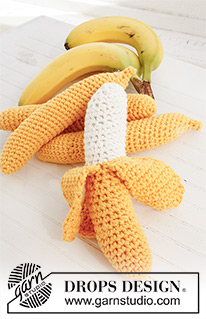


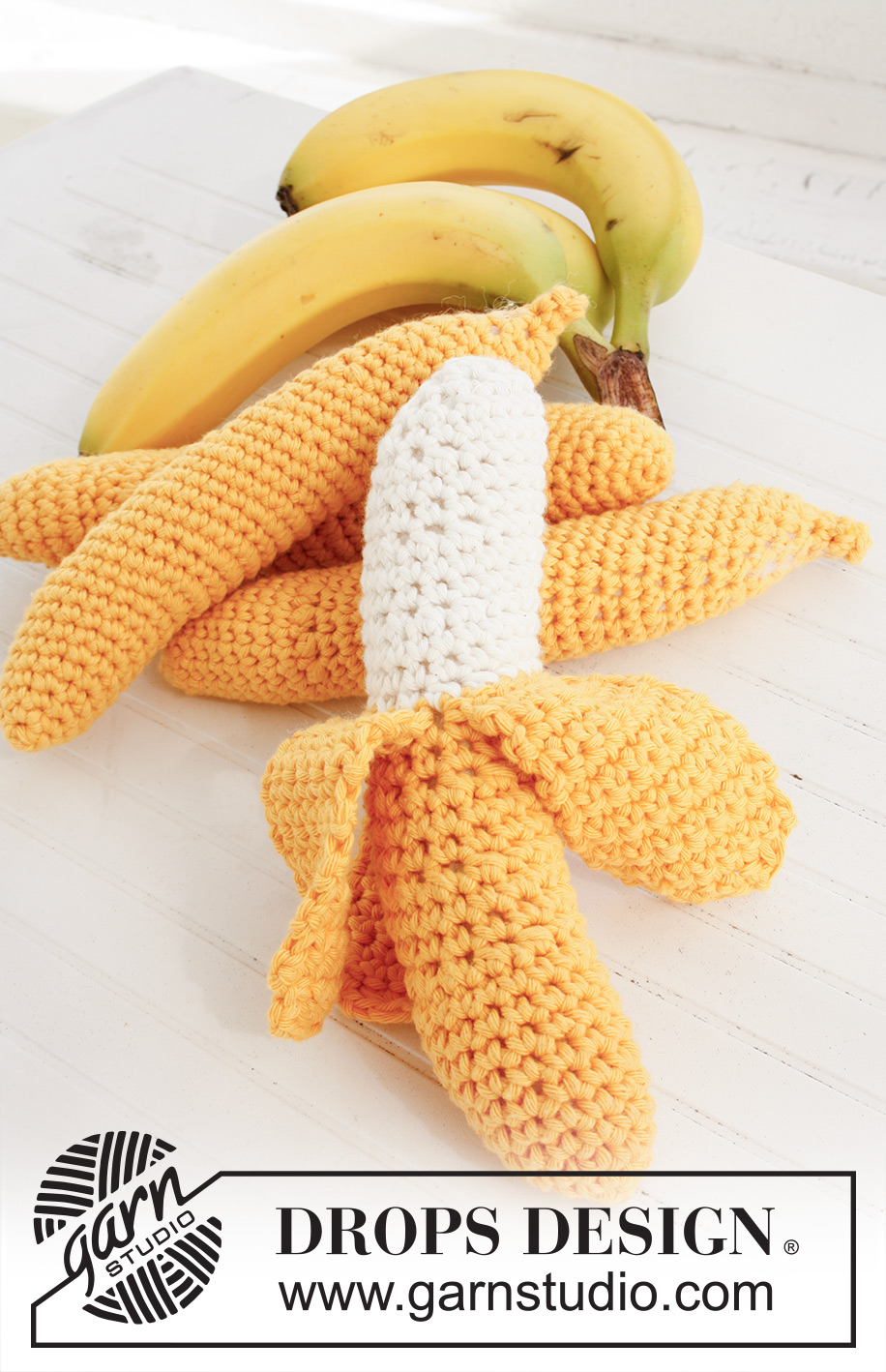










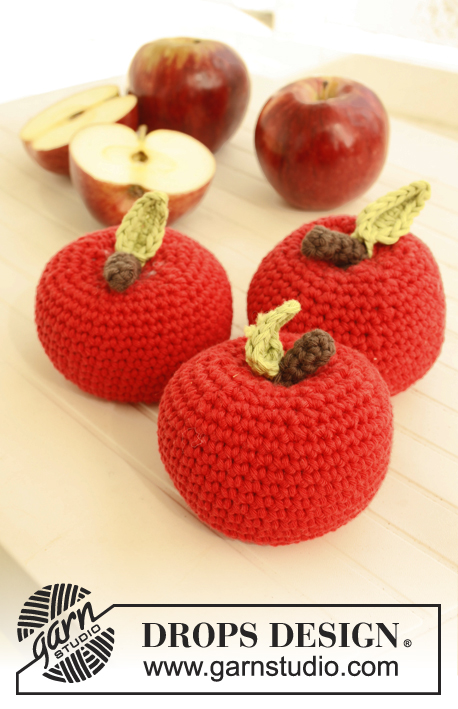
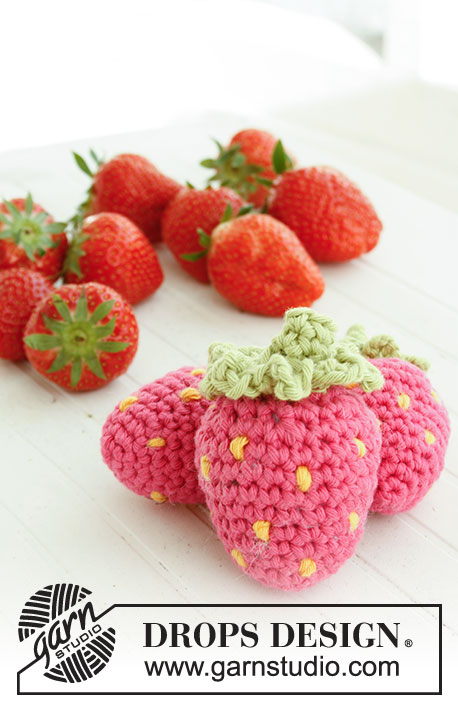
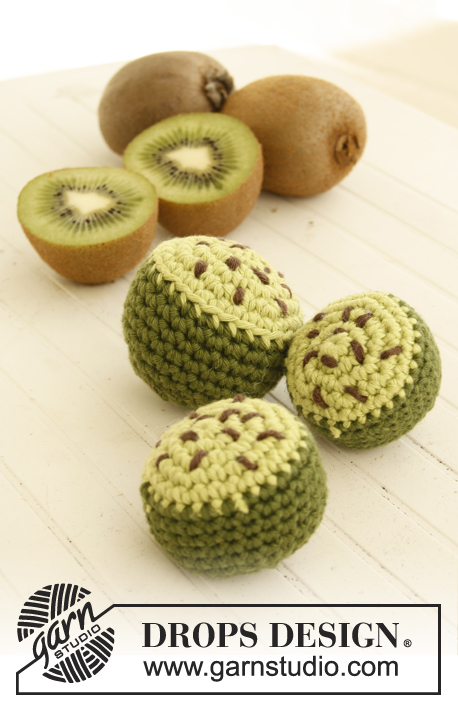




















Post a comment to pattern DROPS Children 23-63
We would love to hear what you have to say about this pattern!
If you want to leave a question, please make sure you select the correct category in the form below, to speed up the answering process. Required fields are marked *.